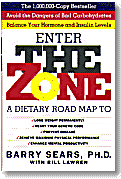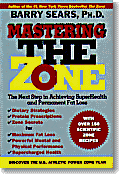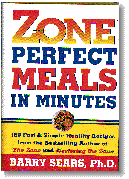 Few dietary programs
have had the kind of impact on the national
consciousness as that of Dr. Barry Sears, whose program, known
as "The Zone Diet," has spawned not less than four best-selling
books on the subject. This page details the specifics of his
thinking and how it relates to his dietary recommendations.
For those who want to follow the "Zone Diet," our message is
simple: you do not need to reply on animal proteins to achieve
your dietary goals. Vegetable proteins will allow you to arrive
at your destination... Few dietary programs
have had the kind of impact on the national
consciousness as that of Dr. Barry Sears, whose program, known
as "The Zone Diet," has spawned not less than four best-selling
books on the subject. This page details the specifics of his
thinking and how it relates to his dietary recommendations.
For those who want to follow the "Zone Diet," our message is
simple: you do not need to reply on animal proteins to achieve
your dietary goals. Vegetable proteins will allow you to arrive
at your destination...
 Now, for a quick review
of Sears' major principles: Now, for a quick review
of Sears' major principles:
Fatter Than Ever!
 For years, Americans have been told to cut down on fats.
"Fat makes you fat." "If you want to lose weight, then cut
down on your fat calories," etc. And it would seem to make
sense, wouldn't it? I mean... weren't we taught in high
school biology that fat has twice the calories per gram
that protein and carbs do? And yet, Americans are eating
less fat than ever before and getting fatter than ever before --
so what gives?
For years, Americans have been told to cut down on fats.
"Fat makes you fat." "If you want to lose weight, then cut
down on your fat calories," etc. And it would seem to make
sense, wouldn't it? I mean... weren't we taught in high
school biology that fat has twice the calories per gram
that protein and carbs do? And yet, Americans are eating
less fat than ever before and getting fatter than ever before --
so what gives?
 Well, the answer is
remarkably simple: the "caloric intake" model is just plain
wrong. It's been scientifically debunked. The gaining and
losing of weight is determined by the hormone, insulin;
not the raw calorie counts of the consumed foods themselves.
And fat doesn't raise insulin levels. Only carbohydrates do.
There are, as it turns out, about 25% of adults who are
lucky enough to be blessed with "low insulin response" --
(we've all met people who could eat whatever they want and
never seem to get fat!) -- but the rest of us aren't so lucky. Well, the answer is
remarkably simple: the "caloric intake" model is just plain
wrong. It's been scientifically debunked. The gaining and
losing of weight is determined by the hormone, insulin;
not the raw calorie counts of the consumed foods themselves.
And fat doesn't raise insulin levels. Only carbohydrates do.
There are, as it turns out, about 25% of adults who are
lucky enough to be blessed with "low insulin response" --
(we've all met people who could eat whatever they want and
never seem to get fat!) -- but the rest of us aren't so lucky.
Carb-Based Diet Only Recent
 Early man was exposed
to two food groups only: low-fat protein and low-density
carbohydrates (fruits and vegetables). Consequently, this is
what man is genetically designed to eat. Grains came into
the picture about 10,000 years ago, and where human society
shifted to grain-eating, archaelogical research tells us that
three immediate and dramatic changes took place. Dr. Sears
write: Early man was exposed
to two food groups only: low-fat protein and low-density
carbohydrates (fruits and vegetables). Consequently, this is
what man is genetically designed to eat. Grains came into
the picture about 10,000 years ago, and where human society
shifted to grain-eating, archaelogical research tells us that
three immediate and dramatic changes took place. Dr. Sears
write:
- Mankind shrank in height from lack of adequate protein.
- Diseases of "modern civilization," such as heart attacks,
first appeared.
- Obesity first became apparent.
 Sears goes on to compare
Egyptian mummies to the skeletons of Neo-Paleolithic man.
"Ancient Egyptians were shorter by about six inches than
Neo-Paleolithic man, probably because the Egyptians' protein
consumption had dropped so dramatically." Ancient Egyptian
medical textbooks going back 3,500 years actually describe
heart disease in "frightening detail." These writings
are confirmed with the discovery of atherosclerotic lesions
on mummies with preserved visceral tissue, even though
the average Egyptian lifespan was only twenty years. Sears goes on to compare
Egyptian mummies to the skeletons of Neo-Paleolithic man.
"Ancient Egyptians were shorter by about six inches than
Neo-Paleolithic man, probably because the Egyptians' protein
consumption had dropped so dramatically." Ancient Egyptian
medical textbooks going back 3,500 years actually describe
heart disease in "frightening detail." These writings
are confirmed with the discovery of atherosclerotic lesions
on mummies with preserved visceral tissue, even though
the average Egyptian lifespan was only twenty years.
 "Finally," Sears writes,
"it is estimated that the extent of obesity in ancient
Egypt was similar to the extent of obesity currently found
in the United States. We can determine this from the excess
amount of skin folds found around the midsections of
preserved Egyptian mummies. (Keep in mind that the diet
eaten by the ancient Egyptians was very similar to the
diet now recommended by the U.S. government for every American.
Talk about history repeating itself.)" "Finally," Sears writes,
"it is estimated that the extent of obesity in ancient
Egypt was similar to the extent of obesity currently found
in the United States. We can determine this from the excess
amount of skin folds found around the midsections of
preserved Egyptian mummies. (Keep in mind that the diet
eaten by the ancient Egyptians was very similar to the
diet now recommended by the U.S. government for every American.
Talk about history repeating itself.)"
It Takes Fat to Burn Fat
 What the calorie-counting
crowd doesn't know yet is that fat acts like a "control rod" in
a nuclear reactor. Fat slows down the entry rate of carbs into
the bloodstream, thus decreasing insulin production. Fat also
tells the brain (with a hormonal signal) to stop eating -- yet
another way it reduces the production of insulin. What the calorie-counting
crowd doesn't know yet is that fat acts like a "control rod" in
a nuclear reactor. Fat slows down the entry rate of carbs into
the bloodstream, thus decreasing insulin production. Fat also
tells the brain (with a hormonal signal) to stop eating -- yet
another way it reduces the production of insulin.
 Because excess insulin
makes you fat, having more fat in the diet is vital for reducing
insulin. The best types are monounsaturated: olive oil,
guacamole, almonds, and unhydrogenated
soybean oil (which Lumen Foods uses). Because excess insulin
makes you fat, having more fat in the diet is vital for reducing
insulin. The best types are monounsaturated: olive oil,
guacamole, almonds, and unhydrogenated
soybean oil (which Lumen Foods uses).
Accessing Your Excess Fat
 At any given moment,
the average American adult carries a minimum of 100,000
calories of stored body fat. That's the equivalent
of 1,700 pancakes. The Zone Diet (and we will discuss
the Lumen Foods version in a moment allows people
to access this massive amount of energy which is already
stored in the body. At any given moment,
the average American adult carries a minimum of 100,000
calories of stored body fat. That's the equivalent
of 1,700 pancakes. The Zone Diet (and we will discuss
the Lumen Foods version in a moment allows people
to access this massive amount of energy which is already
stored in the body.
Elevated Insulin
& Heart Disease
 How can you tell if you're
insulin level is too high? Your size. If you're plump and
"shaped like an apple," you have high insulin levels, and you're
at a high risk of an early heart attack. Nonetheless, you can
still be thin and have elevated insulin: with high triglycerides
and low HDL cholesterol. It is for this reason that high-carb,
low-fat diets are dangerous to cardiovascular patients (even if
they lose weight). They often have an increase in triglycerides
and a decrease in HDL cholesterol levels. This has been made
possible by years of confusing information, including recommendations
by the National Research Council's comittee and the Consumer
Reports panel on nutritional guidelines. Both have been
recommending low-fat, high-carb diets for years. Of no help
either has been the radical position of "low-fat gurus" such
as Nathan Pritikin (now dead) who advocate a diet of 5-10% fat,
10-15% protein, and a whopping 75-85% carbohydrates. How can you tell if you're
insulin level is too high? Your size. If you're plump and
"shaped like an apple," you have high insulin levels, and you're
at a high risk of an early heart attack. Nonetheless, you can
still be thin and have elevated insulin: with high triglycerides
and low HDL cholesterol. It is for this reason that high-carb,
low-fat diets are dangerous to cardiovascular patients (even if
they lose weight). They often have an increase in triglycerides
and a decrease in HDL cholesterol levels. This has been made
possible by years of confusing information, including recommendations
by the National Research Council's comittee and the Consumer
Reports panel on nutritional guidelines. Both have been
recommending low-fat, high-carb diets for years. Of no help
either has been the radical position of "low-fat gurus" such
as Nathan Pritikin (now dead) who advocate a diet of 5-10% fat,
10-15% protein, and a whopping 75-85% carbohydrates.
 So what can you do to lose
weight permanently? Enhance mental productivity? Help prevent
degenerative disease and reset your genetic code? Read our
conclusion to this article on the next page . . .
So what can you do to lose
weight permanently? Enhance mental productivity? Help prevent
degenerative disease and reset your genetic code? Read our
conclusion to this article on the next page . . .
|
|
Sears Major
Dietary Points
- Fat makes you fat. (Sears: It can... but
only in the presence of an elevated insulin level, brought on
by excessive carbohydrates.)
- The goal of exercise is to burn calories, which in turn
burns fat. (Insulin plays an infinitely bigger role.
The calories you burn in most forms of aerobic exercise are
regained with just one or two bran muffins. If you run an
entire marathon, you only consume 2,000 calories - an amount
that every adult stores in their body in carbohydrates alone.)
- You can lose weight by restricting calories -- you only
need willpower! (Truth: Eating less and losing excess
body fat do not necessarily go hand in hand. A diet that is
low-calorie, high-carbohydrate actually works against the
dieter: it generates a series of biochemical signals that make
it more difficult to access stored body fat for energy. The
result: you reach a weight-loss plateau, beyond which you
simply can't lose any more weight. The most destructive aspect
of this myth is that the dieter almost always get tired of feeling
hungry and deprived, so they go off the diet, put the weight
back on (mostly increased body fat), and then feel bad about
themselves for not having sufficient will power, discipline,
or motivation.)
- Starches are better for you than sugars. (Sears:
Carbs are carbs, simple or complex. Gram for gram both have
the same caloric value. Both similarly raise blood triglyceride
levels. Your body treats the carbs in a two ounce candy bar
the same way it does two ounces of
complex carbohydrates in a plate of pasta: both raise insulin.
Both tell the body: store more fat now!)
- Sugars affect your hormones faster and more radically
then starches. (Sears: The exact opposite is true.
The entry rate of a carbohydrate into the bloodstream is known
as its glycemic index. The lower the glycemic index,
the slower the rate of absorption. The fact is, refined
table sugar has a lower glycemic index than most breakfast
cereals. A food which is basic to many weight-reduction
programs, puffed rice cakes, has one of the highest
glycemic indices -- higher than even ice cream, which is
supposed to be a weight watcher's worst enemy.
- Athletes perform better on a high-carb, low-fat diet.
(Sears: Dr. Sears, working in conjunction with several athletic
programs nationwide, most notably the Stanford University swim team,
has consistently demonstrated that athletic performance improves
with a moderate carb / protein / fat model: again, a dietary model built
on a caloric intake of 40% carbohydrate, 30% protein, and 30% fat.
This is less carb and more fat that conventional wisdom
suggests.
- Juicing is a better way to ingest nutrients.
(Another dangerous fad: juicing increases carbohydrate density,
and removes a primary control rod -- fiber -- from the
carbohydrate, meaning that the carbohydrate enters the
bloodstream too fast.
- Higher protein means more animal. Not necessarily.
Sears most recent book details his belief
in soy as a suitable
substitute for animal protein sources. In fact, using vegetable
sources alone, you can easily reach the Zone target
of 30% caloric protein intake. We examine this approach on the
following page.
|



